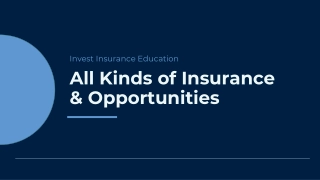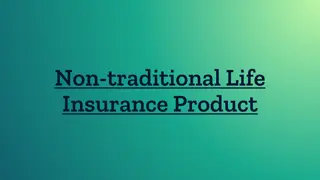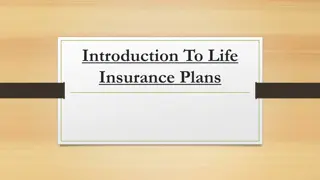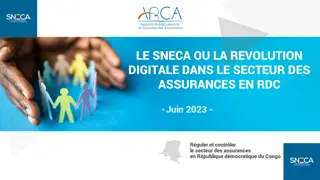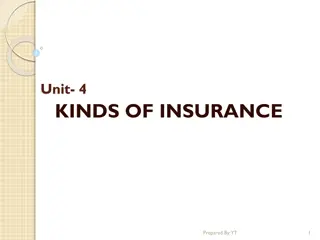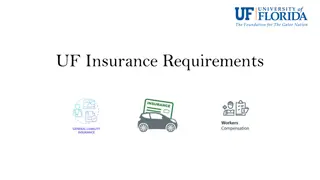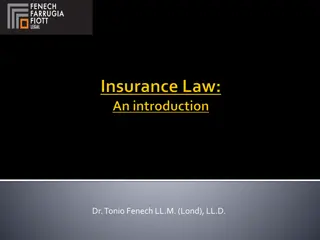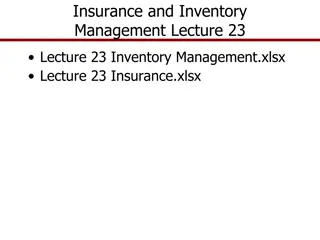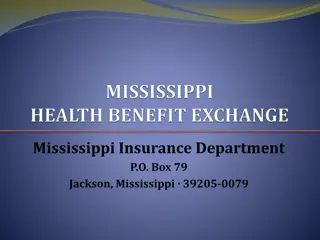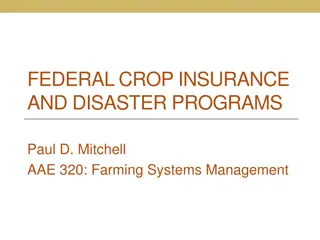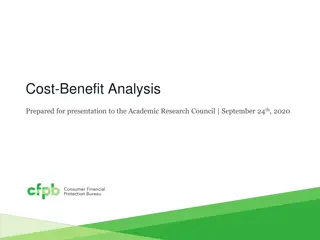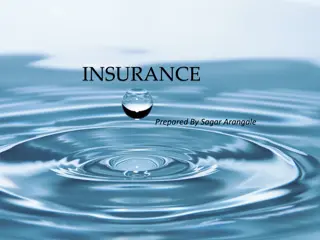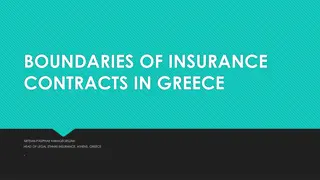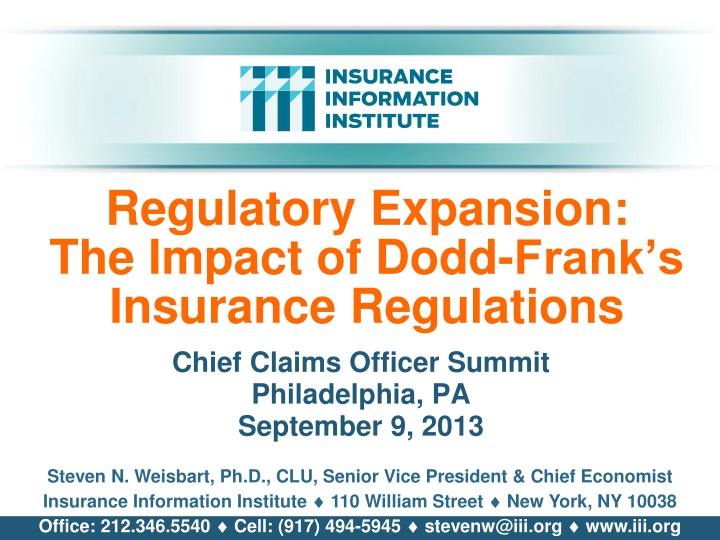
Impact of Dodd-Frank Insurance Regulations
The presentation outlines the impact of Dodd-Frank's insurance regulations discussed at the Chief Claims Officer Summit in Philadelphia. It covers the Federal Insurance Office, Financial Stability Oversight Council, Consumer Financial Protection Bureau, and more. The Federal Insurance Office's organization, authority, and role in monitoring the insurance industry are highlighted. It discusses supervising insurers as nonbank financial entities, coordinating federal efforts on international insurance matters, and consulting with states on national and international insurance issues.
Download Presentation

Please find below an Image/Link to download the presentation.
The content on the website is provided AS IS for your information and personal use only. It may not be sold, licensed, or shared on other websites without obtaining consent from the author. If you encounter any issues during the download, it is possible that the publisher has removed the file from their server.
You are allowed to download the files provided on this website for personal or commercial use, subject to the condition that they are used lawfully. All files are the property of their respective owners.
The content on the website is provided AS IS for your information and personal use only. It may not be sold, licensed, or shared on other websites without obtaining consent from the author.
E N D
Presentation Transcript
Regulatory Expansion: The Impact of Dodd-Frank s Insurance Regulations Chief Claims Officer Summit Philadelphia, PA September 9, 2013 Steven N. Weisbart, Ph.D., CLU, Senior Vice President & Chief Economist Insurance Information Institute 110 William Street New York, NY 10038 Office: 212.346.5540 Cell: (917) 494-5945 stevenw@iii.org www.iii.org
Presentation Outline The Federal Insurance Office The Financial Stability Oversight Council The Consumer Financial Protection Bureau The Office of Financial Research Dodd-Frank and Insurance: The Years Ahead Insurance Industry Financial Strength Q & A 2
The Federal Insurance Office (FIO) 3
The Federal Insurance Office (FIO) Organization in the Department of Treasury, under the Office of Domestic Finance, under the Office of Financial Institutions Headed by a Director who is appointed by the Secretary of Treasury Currently Michael T. McRaith (formerly Director of Illinois Department of Insurance) Took office on June 1, 2011 Small staff (6 people as of May 1, 2013); McRaith has said he expects to have 10-15 Sources: Insurance Information Institute (I.I.I.) updates and research; The Financial Services Roundtable; Adapted from summary by Dewey & LeBoeuf LLP; and http://www.treasury.gov/initiatives/fsoc/about/council/Pages/michael_mcraith.aspx 4
Authority of the Federal Insurance Office (FIO) Monitor all aspects of the insurance industry, identify regulatory gaps that could contribute to a systemic crisis in the insurance industry or the U.S. financial system, Monitor access to affordable insurance for traditionally underserved communities and consumers, minorities and low- and moderate income persons, Recommend to the Financial Stability Oversight Council that it designate an insurer as an entity subject to regulation as a nonbank financial company to be supervised by the Board of Governors of the Federal Reserve System [a SIFI], Coordinate federal efforts and develop federal policy on prudential aspects of international insurance matters, including representing the United States in the IAIS, and assisting the [Treasury] Secretary in negotiating covered agreements, and Consult with States regarding insurance matters of national importance and prudential insurance matters of international importance. Sources: http://www.treasury.gov/initiatives/fio/reports-and- notices/Documents/FIO%20Annual%20Report%202013.pdf ; Insurance Information Institute 5
The Office of Domestic Finance in the U.S. Treasury Department FIO reports to this office 6
FIO within the Office of Domestic Finance in the U.S. Treasury Department Assistant Secretary, Financial Institutions Under Secretary, Domestic Finance Deputy Assistant Secretary, Financial Institutions Policy FIO & TRIA admin 7
The Federal Insurance Office (FIO) Action Roles To represent the United States on prudential aspects of international insurance matters, including at the International Association of Insurance Supervisors To assist the Secretary [of the Treasury] with administration of the Terrorism Risk Insurance Program May require, via subpoenas, that insurers submit data (except small insurers) Sources: Insurance Information Institute (I.I.I.) updates and research; The Financial Services Roundtable; Adapted from summary by Dewey & LeBoeuf LLP; and http://www.treasury.gov/initiatives/fsoc/about/council/Pages/michael_mcraith.aspx 8
The Federal Insurance Office (FIO) Reports to the President and Congress Required annually State of the Insurance Industry Under Dodd-Frank, FIO s First Annual Report was due January 21, 2012 It was released on June 12, 2013. FIO actions taken regarding pre-emption of inconsistent state insurance measures First report, for FY 2012: FIO took no actions One-time Report to Congress on the current state of the market for natural catastrophe insurance in the United States. required by the Biggert-Waters Flood Insurance Reform Act of 2012 Sources: Insurance Information Institute (I.I.I.) updates and research; The Financial Services Roundtable; Adapted from summary by Dewey & LeBoeuf LLP; and http://www.treasury.gov/initiatives/fsoc/about/council/Pages/michael_mcraith.aspx 9
The FIOs First Annual Report on the Insurance Industry Covers Life/Annuity and Property/Casualty sectors but (mainly) not Health insurers 20-page section contains very general descriptions of financial characteristics of the L/A and P/C sectors, mainly for 2008-2012 generally says they took hits during the recession but are recovering now Report also has short descriptive sections on insurer impairments, distribution channels, and reinsurance Report briefly describes 4 current issues & emerging trends Impact of low interest rates Natural catastrophes Changing U.S. demographics Growth opportunities in emerging markets Sources: http://www.treasury.gov/initiatives/fio/reports-and-notices/Documents/FIO%20Annual%20Report%202013.pdf ; Insurance Information Institute 10
The FIOs First Annual Report on the Insurance Industry (cont d) Report devotes 3 pages to a summary of recent changes in state regulation of insurance Report only implicitly identifies gaps in state regulation For example, it describes the importance of enhanced group supervision of insurer holding companies and notes that, as of April 2013, only 14 states have enacted the NAIC s amended [in 2010] Model Insurance Holding Company Act* But it makes no recommendation regarding the other states or the system of regulation overall *Actually, as of the NAIC s Spring 2013 meeting, 15 states and Puerto Rico had adopted the amended Model Act California, Connecticut, Idaho, Indiana, Kansas, Kentucky, Louisiana, Maryland, Mississippi, Nebraska, Pennsylvania, Rhode Island, Texas, West Virginia, and Wyoming. Also, New York has issued a regulation that includes some aspects of the amended Model Act. Sources: http://www.treasury.gov/initiatives/fio/reports-and-notices/Documents/FIO%20Annual%20Report%202013.pdf ; http://www.willkie.com/files/tbl_s29Publications%5CFileUpload5686%5C4365%5CNAIC_Report_2013_Spring_National_Meeting1 .pdf ; Insurance Information Institute 11
Hurricane Sandy Rebuilding Strategy Task Force Recommendations: The FIO s Role Assist the Department of Homeland Security (DHS) in encouraging and promoting IBHS FORTIFIED home programs and Resilience STAR development standards* Work with HUD and FEMA to analyze the affordability of flood insurance and the impact of rate increases on economically-distressed households Support FEMA in its efforts to reduce consumer confusion regarding flood risk and insurance coverage Notes that the BW-12 report deadline was missed because of a dearth of data Report says just scoping the study will take 2 years. *IBHS is the Insurance Institute for Business and Home Safety. FORTIFIED is a construction program developed by IBHS. Resilience STAR is a designation developed by DHS for homes designed and constructed to be resilient to natural disasters. Source: Nelson, Levine, de Luca, & Hamilton, FIO Focus, August 23, 2013, at nldhpublications@nldhlaw.com 12
The Financial Stability Oversight Council (FSOC) 13
10 Voting Members of the FSOC the Secretary of the Treasury, who serves as the Chairperson of the Council; the Chairman of the Board of Governors of the Federal Reserve System; the Comptroller of the Currency (OCC); the Director of the Bureau of Consumer Financial Protection (CFPB); the Chairman of the Securities and Exchange Commission (SEC); the Chairperson of the Federal Deposit Insurance Corporation (FDIC); the Chairperson of the Commodity Futures Trading Commission (CFTC); the Director of the Federal Housing Finance Agency (FHFA); the Chairman of the National Credit Union Administration (NCUA); and an independent member with insurance expertise who is appointed by the President and confirmed by the Senate for a six-year term. Currently, this is Roy Woodall, formerly Kentucky Insurance Commissioner 14
5 Nonvoting (Advisory) Members of the FSOC the Director of the Office of Financial Research; currently Richard Berner, confirmed in January 2013 to serve a six-year term as the first Director of OFR. [OFR is in the Treasury Department.] Before joining the OFR, Berner was a Managing Director, Co-Head of Global Economics and Chief U.S. Economist at Morgan Stanley. the Director of the Federal Insurance Office; currently Michael McRaith a state insurance commissioner designated by the state insurance commissioners; currently John Huff of Missouri; however, he is not allowed to brief fellow state insurance regulators on FSOC discussions a state banking supervisor designated by the state banking supervisors; and a state securities commissioner(or officer performing like functions) designated by the state securities commissioners. The state insurance commissioner, state banking supervisor, and state securities commissioner serve two-year terms. 15
FSOC Can Designate Insurers as Systemically Important Designation means the insurer (or its holding company) could be a threat to the stability of the U.S. financial system Designation requires 2/3 of FSOC members to vote yes, including Treasury Secretary Note: only 1 of 10 FSOC voters has insurance expertise Imposes new regulation by the Federal Reserve Sources: http://www.treasury.gov/initiatives/fio/reports-and-notices/Documents/FIO%20Annual%20Report%202013.pdf ; Insurance Information Institute 16
SIFI Designation Protocol All banks with assets > $50B are deemed Systemically Important Non-bank financial groups (such as insurers) with global consolidated assets > $50B will be examined for Systemic Riskiness But not automatically designated as a Systemically Important Financial Institution (SIFI) Foreign firms with assets in the US exceeding $50 billion will also fall under review If Firm Exceeds the $50B Threshold, a 3- Stage Test Applies Sources: Financial Stability Oversight Council; Insurance Information Institute (I.I.I.) research. 17
US Insurer Groups, Total Insurance Assets Greater than $150 Billion, 2012 $738 MetLife $738 Prudential $466 Hartford $461 AIG $439 TIAA-CREF These totals do not include non-insurance-related assets. $352 AEGON $272 AXA $256 Nationwide $252 Manulife $251 State Farm $238 NY Life $217 Berkshire As of year-end 2012, 31 US insurers exceeded the $50B threshold (measured by insurance net-admitted assets), but few met the other criteria for a SIFI designation $203 NW Mut $192 Lincoln $187 ING $178 Ameriprise $168 Mass Mut $158 Allianz $100 $200 $300 $400 $500 $600 $700 $800 There were 5 groups with total insurance assets between $100 billion and $150 billion as of year-end 2012, and 8 groups with total insurance assets between $50 billion and $100 billion. Sources: SNL Financial; I.I.I. calculations 18
SIFI Designation Protocol: 3-Stage Test for Firms with Assets Over $50B STAGE 1: 5 Uniform Quantitative Thresholds, (meeting at least 1 of which will trigger a Stage 2 review) 1. Leverage: Be leveraged more than 15:1 (insurers unlikely to trigger) 2. ST Debt-to-Assets: Have a ratio of ST debt (less than 12 months to maturity) to consolidated assets exceeding 10% 3. Debt: Have total debt exceeding $20 billion (i.e., loans borrowed and bond issues) 4. Derivative Liabilities: Have derivative liabilities exceeding $3.5 billion 5. Credit Default Swaps: Have more than $30 billion CDS outstanding for which the nonbank financial firm is the reference entity (i.e., CDS written against firm s failure) Thresholds considered to be guideposts Not all companies that breach a threshold will be deemed systemically important FSOC can include firms that do meet any of the criteria Sources: Financial Stability Oversight Council; Insurance Information Institute (I.I.I.) research. 19
Derivative Liabilities: Publically Traded US Insurers Few US insurers exceed the $3.5B threshold for derivatives liabilities Source: Barclays Capital 20
Total Debt: Publically Traded US Insurers Few US insurers exceed the $20B threshold for total debt Source: Barclays Capital 21
Gross Notional Amount in Credit Default Swaps on Publically Traded US Insurers Very few US insurers exceed the $30B threshold for CDS written against them Source: Barclays Capital 22
Dodd-Frank Implementation: SYSTEMIC RISK CRITERIA (cont d) STAGE 2: Analysis of Firms Triggering Uniform Quantitative Thresholds Firms will be analyzed using publicly available information in order to conduct a more thorough review No data call will be required at this stage Firms viewed as potentially systemically important (candidate SIFIs) will subject to a Stage 3 analysis STAGE 3: Analysis of Candidate Systemically Important Financial Institutions Firms will be subject to more detailed analysis including data not available during the Stage 2 analysis FSOC will notify Stage 3 firms that they are under SIFI consideration Firms will have the opportunity to contest their consideration Sources: Financial Stability Oversight Council; Insurance Information Institute (I.I.I.) research. 23
Dodd-Frank Implementation: SYSTEMIC RISK CRITERIA (concluded) SIFI DESIGNATION PROCEDURE: 2-Stage Voting Procedure by FSOC is Required Before a Final SIFI Designation is Made At the end of Stage 3, FSOC has the authority to propose a firm be designated as a SIFI Requires 2/3 majority vote of FSOC members, including affirmation of the Chair (Treasury Secretary) Potential SIFI firm will be given written explanation for the determination Firm can request a hearing to contest the determination Final determination requires another 2/3 majority of FSOC members and affirmation of the Chair Sources: Financial Stability Oversight Council; Insurance Information Institute (I.I.I.) research. 24
Liquidating Defaulting Insurers Orderly Liquidation Authority Dodd-Frank gives the FDIC powers to liquidate Systemically Important insurers if the relevant state insurance regulator fails to take action within 60 days. If an insurer designated Systemically Important is in danger of default, The Treasury Secretary can seek to have the FDIC appointed as receiver to liquidate the company, but only after the Secretary gets both a written recommendation to do so from the FIO Director and an approval vote by 2/3 of the governors of the Federal Reserve Sources: http://www.treasury.gov/initiatives/fio/reports-and-notices/Documents/FIO%20Annual%20Report%202013.pdf ; Insurance Information Institute 25
The Nonadmitted and Reinsurance Reform Act (NRRA) 26
The Nonadmitted and Reinsurance Reform Act (NRRA) Title V of Dodd-Frank Affects regulation of surplus lines P/C insurance, but does not apply to workers comp, excess workers comp, or risk retention groups Limits regulatory authority over surplus lines insurance to the home state of the insured Sets federal standards for the collection of surplus lines premium taxes, insurer eligibility, and commercial purchaser exemptions Overrides state laws Sources: Insurance Information Institute (I.I.I.); https://usa.marsh.com/Portals/9/Documents/DownloadAsset.pdf 27
New Regulation of Derivatives Commodities Futures Trading Commission issued new rules regarding derivatives Insurers use derivatives mainly to hedge interest rate risk and currency risk, not for investment/speculation; nonetheless, Insurers required to trade and clear derivative trades on registered exchanges or clearinghouses Require additional collateral Might require additional capital and/or liquidity Collateral requirements will increase 1% - 3% and could go higher Sources: A.M.Best, BestWeek, August 12, 2013, p.8; Insurance Information Institute (I.I.I.) 29
The Consumer Financial Protection Bureau (CFPB) Dodd-Frank Title X (the Consumer Financial Protection Act of 2010), created the CFPB, an independent bureau within the Federal Reserve System 30
Organization of the CFPB Director is appointed by the President, confirmed by the Senate, for a 5-year term The Bureau must have 4 offices: Fair Lending and Equal Opportunity (access to credit) Financial Education (of consumers) Service Member Affairs (for military and families) Financial Protection for Older Americans (financial literacy for those 62 and older) The Bureau must have 3 functional units: Research Community Affairs Collecting and tracking complaints Source: http://www.consumerfinance.gov/the-bureau/ 31
CFPB Staffing (FTE), FY2011-2014 1545 1600 1400 1214 1200 1000 831 800 600 400 178 200 0 2011 2012 2013 2014 The numbers for 2013 and 2014 are lower than previously forecast, likely due to the sequester Source: http://www.consumerfinance.gov/strategic-plan-budget-and-performance-plan-and-report/#budget-overview 32
CFPB Organization Chart: This is not a small agency 33
CFPB Powers and Limitations The Bureau has the authority to administer, enforce, and otherwise implement federal consumer financial laws, which includes the power to make rules, issue orders, and issue guidance. See 12 U.S.C. 5511 (Dodd-Frank Act 1021). The Financial Stability Oversight Council (FSOC) has the power to set aside any of the Bureau s regulations if the FSOC decides that the regulation would put the safety and soundness of the banking system, or the stability of the financial system of the United States, at risk. Source: http://www.law.cornell.edu/wex/dodd-frank_title_x 34
Functions of the CFPB (any or all of which might affect insurance) Write rules, supervise companies, and enforce federal consumer financial protection laws Restrict unfair, deceptive, or abusive acts or practices Take consumer complaints Promote financial education Research consumer behavior Monitor financial markets for new risks to consumers Enforce laws that outlaw discrimination and other unfair treatment in consumer finance Source: http://www.consumerfinance.gov/the-bureau/ 35
Recent CFPB Action Affecting Insurance Lender-placed insurance New rules prevent servicer surprises and runarounds for mortgage borrowers Servicers typically must make sure borrowers maintain property insurance and if the borrower does not, the servicer generally has the right to purchase it. The CFPB s rules ensure consumers will not be surprised by this insurance, which often can be more expensive than the insurance borrowers buy on their own. The rules say servicers must provide more transparency in this process, including advance notice and pricing information before charging consumers. Servicers must also have a reasonable basis for concluding that a borrower lacks such insurance before purchasing a new policy. If servicers buy the insurance but receive evidence that it was not needed, they must terminate it within fifteen days and refund the premiums. Source: http://www.consumerfinance.gov/the-bureau/ 36
The Office of Financial Research (OFR) 37
OFR within the Office of Domestic Finance in the U.S. Treasury Department Office of Financial Research reports to Under Secretary for Domestic Finance FIO & TRIA admin 38
What the Office of Financial Research is Supposed to Do Support the Financial Stability Oversight Council (Council) and member agencies by: 1. collecting data on behalf of the Council, and providing such data to the Council and member agencies; 2. standardizing the types and formats of data reported and collected; 3. performing applied research and essential long-term research; 4. developing tools for risk measurement and monitoring; 5. performing other related services; 6. making the results of the activities of the Office available to financial regulatory agencies; and 7. assisting such member agencies in determining the types and formats of data authorized by this Act to be collected by such member agencies. Source: http://www.treasury.gov/initiatives/wsr/ofr/Documents/Office-of-Financial-Research.pdf 39
The OFRs Research and Analysis Center On behalf of the FSOC, the Center will develop and maintain independent analytical capabilities and computing resources to a. develop and maintain metrics and reporting systems for risks to the financial stability of the United States; b. monitor, investigate, and report on changes in systemwide risk levels and patterns to the FSOC and Congress; c. conduct, coordinate, and sponsor research to support and improve regulation of financial entities and markets; d. evaluate and report on stress tests or other stability-related evaluations of financial entities overseen by the member agencies; e. maintain expertise in such areas as may be necessary to support specific requests for advice and assistance from financial regulators; f. investigate disruptions and failures in the financial markets, report findings, and make recommendations to the FSOC based on those findings; g. conduct studies and provide advice on the impact of policies related to systemic risk; and h. promote best practices for financial risk management. Source: http://www.treasury.gov/initiatives/wsr/ofr/Documents/Office-of-Financial-Research.pdf 40
OFR Organization Chart: This is not a small agency Research & Analysis Center Financial Institutions & Markets 41
Dodd-Frank and Insurance: The Years Ahead Questions Regarding both Domestic and International Regulation 42
New Rulemakings Under Dodd-Frank By the time it s done, at least 250-300* new rulemakings are expected under Dodd- Frank, resulting in increasing complexity, cost, discord and slowing Implementation 95 100 90 80 70 61 56 60 54 50 40 31 30 24 17 20 9 10 4 2 0 Consumer Financial Protection Bureau CFTC Financial Stability Oversight Council FDIC Federal Reserve FTC OCC Office of Financial Research SEC Treasury * Total eliminates double counting for joint rule-makings and this estimate only includes explicit rule-makings in the bill, and thus likely represents a significant underestimate. Source: Wall Street Journal, July 14, 2010; Davis Polk & Wardwell. 43
Dodd-Frank: What does the future hold for insurers? SIFI Issues Do enhanced capital requirements put SIFIs at a competitive disadvantage, or is the Too Big To Fail designation viewed as an advantage? FSOC SIFI Designations: Initially 2 - 3 US insurers [Prudential Financial, AIG, maybe MetLife?], but will research and/or political pressure expand the list? The UK s Financial Stability Board designated 9 Globally Systemically Important Insurers (G-SIIs) US-based Insurers AIG MetLife Prudential Financial Non-US-based Insurers Aviva (UK) AXA (France) Allianz (Germany) Generali (Italy) Ping An (China) Prudential (UK) Source: Insurance Information Institute (I.I.I.) updates and research. 44
G-SIFI Timetable for Enhanced Capital Requirements Enhanced capital requirements to be spelled out by the IAIS at the G-20 Summit in 2014. Implementation details to come by the end of 2015. Capital requirements will apply starting January 2019 To G-SIIs designated as of November 2017 Sources: A.M. Best, BestWeek, July 29, 2013; Insurance Information Institute 45
Dodd-Frank: Future Issues Short-to-Mid-Term Issues Outcome of new 250-300 rules across many federal agencies (ETA: months to years) Legal challenges to the Dodd-Frank (ETA: Years) Mid-to-Longer-Term Issues Solvency II and ComFrame: Tough sell in the US right now (Solvency II = Basel III = European Banks) Source: Insurance Information Institute (I.I.I.) updates and research. 46
How Extensive/Intrusive will the CFPB be Regarding Insurance Market Conduct? A major initiative of the CFPB is improving financial literacy and financial decision-making The CFPB is conducting research to develop measures of financial well-being How can this not involve insurance? Particular attention is likely to be paid to three audiences: military personnel (and their families), people over age 62, and the underserved It seems likely that, at some point, the CFPB will focus on health insurance, property insurance, and retirement 47
How Intrusive will the OFR be into Insurance? Regarding Insurance Operations Data Collection? The OFR is to develop metrics for risks to the financial stability of the US Will it collect data only from SIFI insurers or a broader range of insurers? The OFR is to evaluate and report on stress tests of financial entities overseen by the member agencies Does this include stress tests of insurer SIFIs? Of Non-SIFI insurers? 48
Dodd-Frank: Longer-term Issues for Insurers Streamlining U.S. Regulation: Dodd-Frank does little to directly address the inefficiencies of the US insurance regulatory system Low likelihood of timely, uniform implementation of regulation (FIO has no regulatory power; Treasury/Fed powers very limited) But CFPB, OFR might add to the regulatory burden International Regulation Dodd-Frank provides little guidance on international insurance issues, though FIO will define its role on this issue Elements of Dodd-Frank (e.g., derivatives regulation) could prove useful Source: Insurance Information Institute (I.I.I.) updates and research. 49
Insurance Industry Financial Strength The US financial system has little to fear from the US Insurance Industry 50

